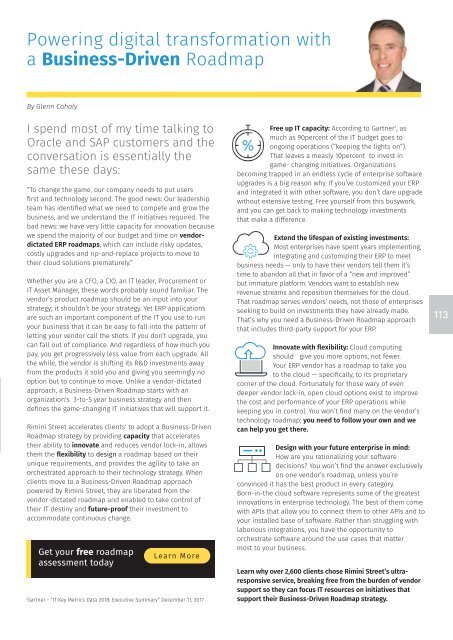Business Chief USA April 2019
Create successful ePaper yourself
Turn your PDF publications into a flip-book with our unique Google optimized e-Paper software.
Powering digital transformation with<br />
a <strong>Business</strong>-Driven Roadmap<br />
By Glenn Cahaly<br />
I spend most of my time talking to<br />
Oracle and SAP customers and the<br />
conversation is essentially the<br />
same these days:<br />
“To change the game, our company needs to put users<br />
first and technology second. The good news: Our leadership<br />
team has identified what we need to compete and grow the<br />
business, and we understand the IT initiatives required. The<br />
bad news: we have very little capacity for innovation because<br />
we spend the majority of our budget and time on vendordictated<br />
ERP roadmaps, which can include risky updates,<br />
costly upgrades and rip-and-replace projects to move to<br />
their cloud solutions prematurely.”<br />
Whether you are a CFO, a CIO, an IT leader, Procurement or<br />
IT Asset Manager, these words probably sound familiar. The<br />
vendor’s product roadmap should be an input into your<br />
strategy; it shouldn’t be your strategy. Yet ERP applications<br />
are such an important component of the IT you use to run<br />
your business that it can be easy to fall into the pattern of<br />
letting your vendor call the shots. If you don’t upgrade, you<br />
can fall out of compliance. And regardless of how much you<br />
pay, you get progressively less value from each upgrade. All<br />
the while, the vendor is shifting its R&D investments away<br />
from the products it sold you and giving you seemingly no<br />
option but to continue to move. Unlike a vendor-dictated<br />
approach, a <strong>Business</strong>-Driven Roadmap starts with an<br />
organization's 3-to-5 year business strategy and then<br />
defines the game-changing IT initiatives that will support it.<br />
Rimini Street accelerates clients' to adopt a <strong>Business</strong>-Driven<br />
Roadmap strategy by providing capacity that accelerates<br />
their ability to innovate and reduces vendor lock-in, allows<br />
them the flexibility to design a roadmap based on their<br />
unique requirements, and provides the agility to take an<br />
orchestrated approach to their technology strategy. When<br />
clients move to a <strong>Business</strong>-Driven Roadmap approach<br />
powered by Rimini Street, they are liberated from the<br />
vendor-dictated roadmap and enabled to take control of<br />
their IT destiny and future-proof their investment to<br />
accommodate continuous change.<br />
Get your free roadmap<br />
assessment today<br />
Learn More<br />
1<br />
Gartner - “IT Key Metrics Data 2018: Executive Summary” December 11, 2017<br />
Free up IT capacity: According to Gartner 1 , as<br />
much as 90percent of the IT budget goes to<br />
ongoing operations (“keeping the lights on”).<br />
That leaves a measly 10percent to invest in<br />
game- changing initiatives. Organizations<br />
becoming trapped in an endless cycle of enterprise software<br />
upgrades is a big reason why. If you’ve customized your ERP<br />
and integrated it with other software, you don’t dare upgrade<br />
without extensive testing. Free yourself from this busywork,<br />
and you can get back to making technology investments<br />
that make a difference.<br />
Extend the lifespan of existing investments:<br />
Most enterprises have spent years implementing,<br />
integrating and customizing their ERP to meet<br />
business needs — only to have their vendors tell them it’s<br />
time to abandon all that in favor of a “new and improved”<br />
but immature platform. Vendors want to establish new<br />
revenue streams and reposition themselves for the cloud.<br />
That roadmap serves vendors’ needs, not those of enterprises<br />
seeking to build on investments they have already made.<br />
That’s why you need a <strong>Business</strong>-Driven Roadmap approach<br />
that includes third-party support for your ERP.<br />
Innovate with flexibility: Cloud computing<br />
should give you more options, not fewer.<br />
Your ERP vendor has a roadmap to take you<br />
to the cloud — specifically, to its proprietary<br />
corner of the cloud. Fortunately for those wary of even<br />
deeper vendor lock-in, open cloud options exist to improve<br />
the cost and performance of your ERP operations while<br />
keeping you in control. You won’t find many on the vendor’s<br />
technology roadmap; you need to follow your own and we<br />
can help you get there.<br />
Design with your future enterprise in mind:<br />
How are you rationalizing your software<br />
decisions? You won’t find the answer exclusively<br />
on one vendor’s roadmap, unless you’re<br />
convinced it has the best product in every category.<br />
Born-in-the cloud software represents some of the greatest<br />
innovations in enterprise technology. The best of them come<br />
with APIs that allow you to connect them to other APIs and to<br />
your installed base of software. Rather than struggling with<br />
laborious integrations, you have the opportunity to<br />
orchestrate software around the use cases that matter<br />
most to your business.<br />
Learn why over 2,600 clients chose Rimini Street’s ultraresponsive<br />
service, breaking free from the burden of vendor<br />
support so they can focus IT resources on initiatives that<br />
support their <strong>Business</strong>-Driven Roadmap strategy.<br />
113

















